Hello all PIZZA friends and family. I hope everyone had a great holiday.
Just a reminder, this post is part of a blog series where I will go through the process of valuing 2 publicly traded pizza firms; Domino's (Ticker:DPZ) and Papa John's (Ticker:PZZA).
In the previous blog post I covered how to calculate the Cost of Equity for these 2 firms. You can review that blog post here https://peakd.com/hive-185582/@hurtlocker/calculating-the-cost-of-equity-for-dominos-and-papa-johns.

What is the Cost of Debt of a Firm?
The Cost of Debt of a firm is the effective interest rate paid on its combined debt. Debt can include Bonds, loans, lines of credit, etc.
What do we mean by "effective" interest rate? This term is meant to clarify that we want to know the real annual interest rate of the debt. This is in lieu of a rate that has not been adjusted for compounding.
It is important to note Cost of Debt does not include the cost of Preferred Stock.

How to Calculate the Cost of Debt?
When calculating the Cost of Debt of a firm, the method we want to use depends on the amount of information we have available. Given that Domino's and Papa John's are both publicly traded pizza companies, we get to use the easiest and, in my opinion, most accurate method for determining a firm's Cost of Debt. With this method we take the firm's Total Interest Paid divided by the Total Debt of the Firm. Because these companies are public we can look at their financial statements or pull the data from a website that provides this information on publicly traded companies. Some good resources are finance.yahoo.com or morningstar.com.
We need to reference the most current Income Statement for the Interest Expense and the most current Balance Sheet for the Total Debt.


Adjustments to the Cost of Debt Formula
In my last blog post on this topic I mentioned building a financial model is both an art and a science. I make additional adjustments to the Cost of Debt formula that are not necessarily "industry standard." I will explain the adjustments and why I make them below; however, I just want to be clear these adjustments are not broadly accepted.
The main adjustments I make are:
- Use Net Debt versus Total Debt
- Use Net Interest Expense versus Interest Expense
- Adjust Net Debt for loans issued by the firm

Adjustments to the Cost of Debt Formula Detail - 1. Net Debt
Net Debt of a firm is Total Debt less any Cash & Cash Equivalents. I argue that you need to take a firm's cash position into account when assessing their cost of debt. I adjust for this because maintaining a certain level of cash is a indirect cost to owning debt. The more debt a firm owns the more cash they need on hand to service that debt. By reducing the Total Debt by Cash and Cash Equivalents, the firm's effective cost of debt is higher because it reduces the denominator in the formula as shown in the below example.
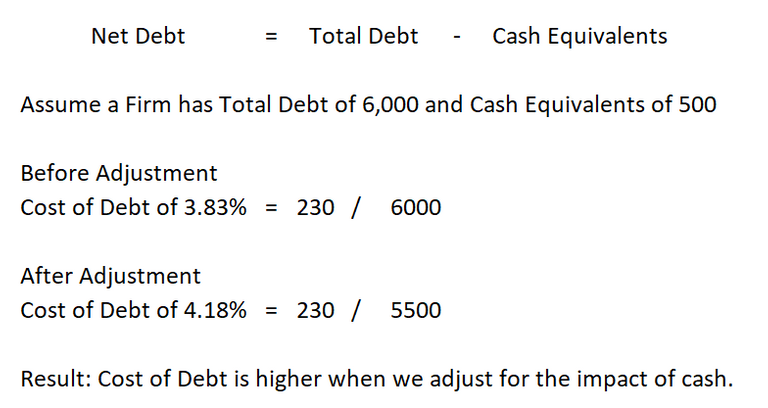
Note: Cash Equivalents are any short-term investment that is considered highly liquid and/or has a short maturity period. By short we mean a security with no longer than 90 days till maturity.

Adjustments to the Cost of Debt Formula Detail - 2. Net Interest Expense
It is common for large corporations to have small lending activities that generate them interest revenue. I argue these activities represent risk that can either increase or decrease a firm's "effective" Cost of Debt. If a firm is efficient with their lending activities it will reduce their Cost of Debt, and vice versa.
Net Interest Expense of a Firm = Interest Expense - Interest Income.
Note: If we are going to adjust for interest income, we also need to adjust for the loan assets generating that interest income. (If we make adjustment 2. we also need to make adjustment 3.)

Adjustments to the Cost of Debt Formula Detail - 3. Remove Loan Assets
If we are going to adjust the Income Statement side of the equation (Interest Income), we need to adjust the Balance Sheet side of the equation (Loan Assets). Therefore, doing this adjustment only make sense if we do adjustment 2. Also, making this adjustment serves as a good check when assessing the capital structure of a firm. If making this adjustment has a significant impact, the firm may have some banking style operations. In short, we are trying to assess the Cost of Debt of pizza companies not banks; we would assess a bank's risk and capital structure differently than we would a pizza company.
Total Net Debt of a Firm = Short Term Debt + Long Term Debt - Cash - Cash Equivalents - Short Term Loans - Long Term Loans
Additional Notes:
- In 2016 the Accounting Standards for Capital Lease Obligations were revised by FASB. This revision makes it easier to adjust for Capital Lease Obligations for publicly traded firm's in the United States. You could argue that Capital Lease Obligations are a form of debt. If you are going to adjust for Capital Lease Obligations, you also need to adjust for the expense associated with those Capital Lease Obligations.

Domino's and Papa John's Net Interest Expense:
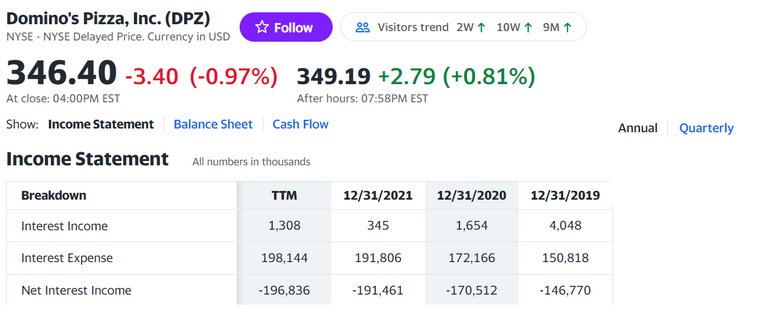
(1.) Domino's Net Interest Expense is $196,836 = $198,144 - $1,308 in thousands
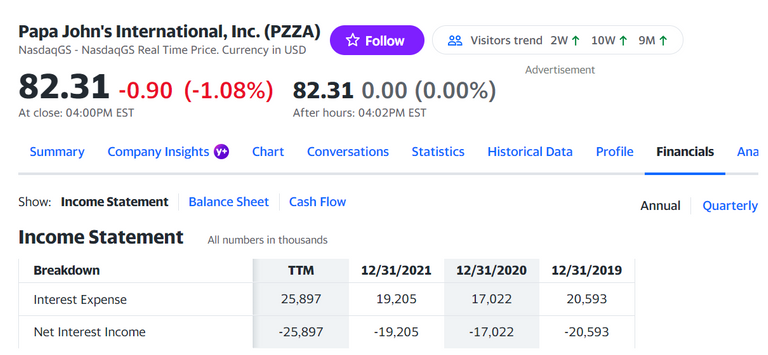
(2.) Papa John's Net Interest Expense is $25,897 = $25,897 + $0 in thousands

Domino's and Papa John's Total Net Debt Adjusted:
(1.) Domino's Adjusted Net Debt is $4,845,728 in thousands
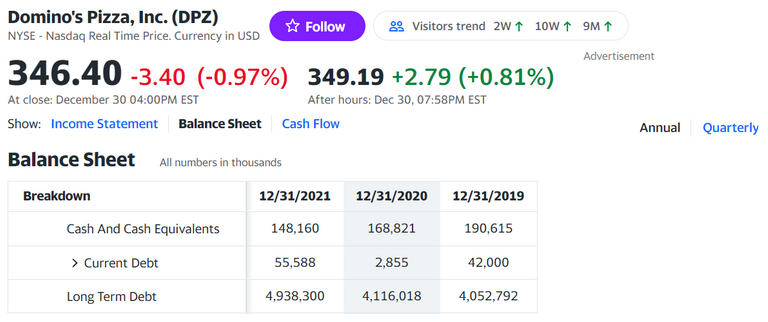

(2.) Papa John's Adjusted Net Debt is $362,264 in thousands



What about the Tax Implications of Debt?
It is important to note that Interest Expense is typically a Tax Deductible Expense. That means our effective Cost of Debt is reduced by the Corporate Tax Rate. This is also referred to the After Tax Cost of Debt. The corporate tax rate in the United States is about 25% so we would multiply the Cost of Debt of our two pizza companies by (1 - 25%) to get the After Tax Cost of Debt.
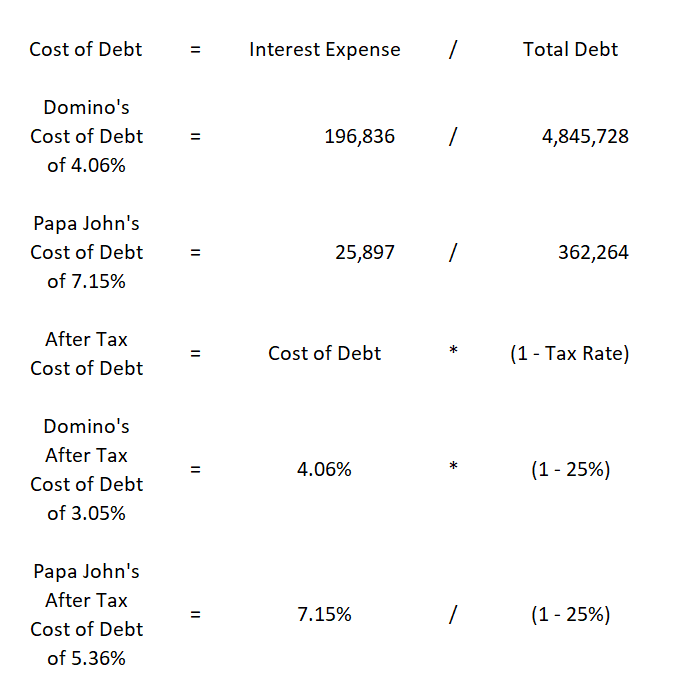

Points About Our Cost of Debt Model:
Just a reminder that I made adjustments to the traditional formulas that not everyone will agree with.
In the previous blog post we covered the Cost of Equity of the 2 pizza companies. Now we know the Cost of Debt as well. In the following blog post we will use this information to calculate each firms Weighted Average Cost of Capital (WACC).

For additional information on valuations I recommend the work of Aswath Damodaran. He is professor of both Valuation and Corporate Finance at the NYU Stern School of Business. He provides his data, notes, and lectures for free on his website https://pages.stern.nyu.edu/~adamodar/

If you haven't heard of Hive PIZZA, we are an awesome gaming guild that also loves pizza.
Come stop by the discord channel for weekly events or even share your own pizza pictures in the #pizza-pics channel.
Join the Hive PIZZA Guild Discord - https://discord.com/invite/hivepizza
Visit Hive Pizza Website - https://hive.pizza/
Follow PIZZA on Twitter - https://twitter.com/PizzaOnHive
Follow me (@hurtlocker) on Twitter - https://twitter.com/Hurtlocker360




